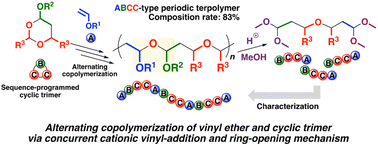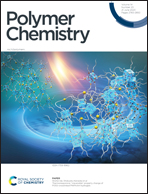Alternating cationic copolymerizations of vinyl ethers and sequence-programmed cyclic trimer consisting of one vinyl ether and two aldehydes for ABCC-type periodic terpolymers†
Abstract
Alternating cationic copolymerizations of 2-chloroethyl vinyl ether (CEVE; unit A) and cyclic trimers prepared from the cyclotrimerization of one vinyl monomer (unit B) and two aldehyde molecules (unit C) were investigated to obtain polymers with ABCC-type monomer sequences. The kinds of vinyl monomers and aldehyde molecules incorporated into the cyclic trimers affected the crossover frequencies during the copolymerizations with CEVE. In particular, a cyclic trimer consisting of isobutyl VE (IBVE) and 2-nonenal (NNE) was highly effective for alternating copolymerizations with CEVE at appropriate monomer concentrations. The obtained alternating copolymers potentially had three different sequences of ABCC-, ACCB-, and ACBC-types due to the different addition and ring-opening modes of the cyclic trimer. Structural analysis of the products obtained by methanolysis of the alternating copolymers revealed that ABCC-type periodic sequences were mainly obtained (83% under optimized conditions).



 Please wait while we load your content...
Please wait while we load your content...